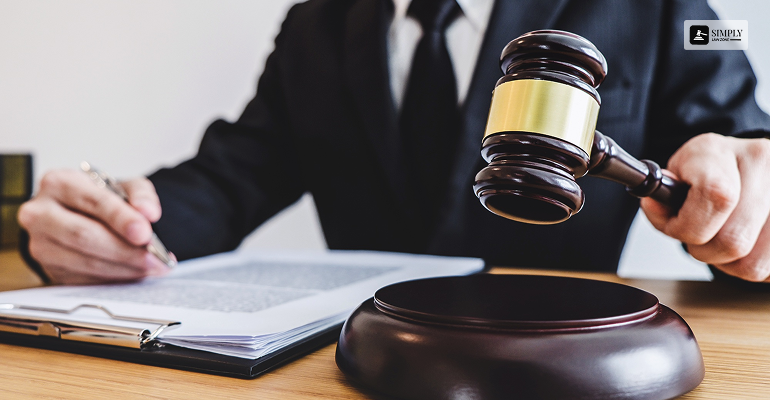
What is Injunctive Relief? Imagine someone is preparing to destroy your priceless, unique property. Money would never truly restore you to your former state. When you find yourself in such a predicament, you need a legal remedy that stops the harmful act prior to the fact.
So, what does injunctive relief mean? It’s a unique kind of court order, an equitable remedy, that requires a party to do something specific or, more often, not to do something specific.
It is mainly used to avoid a present or future wrong when giving money would not be sufficient. Consequently, the role of an injunction is to protect a person’s rights and property from irreparable damage.
This is damage that cannot be rectified with money. This is what makes the injunctive relief a key cornerstone of modern civil contract law and litigation.
Types Of Injunctive Relief
Courts issue different forms of injunctive relief depending on the urgency and the stage of the lawsuit.
Temporary Restraining Orders (TROs)
A Temporary Restraining Order (TRO) is the fastest form of injunctive relief. A court can order this court to order immediately.
This can happen without hearing the other party sometimes in case the moving party can establish an existing threat of immediate and irreparable harm.
Such orders are strictly short-lived, for no more typically ten to fourteen days. Moreover, they are temporary in nature to preserve the status quo until a more formal hearing.
Preliminary Injunctions
A preliminary injunction is an injunction that a court extends following the conduct of a formal hearing. Here, both parties to the case submit evidence. The status quo remains intact throughout the duration of litigation by court order.
Moreover, it may take months or years to conclude a lawsuit. Thus, a preliminary injunction is a powerful tool of injunctive relief. It has the potential to shape the entire legal battle.
Permanent Injunctions
Permanent injunction is a form of final equitable remedy. Notably, a court issues this after the plaintiff wins a case. Unlike the temporary ones, this injunction stays forever or for as long as the court determines.
For instance, a court may issue a permanent injunction to a company not to use any other competitor’s trademark in the future at any time.
Lack Of Swiftness And The Four Pronged Test

Courts are not swift to grant injunctive relief. As a part of an extraordinary judicial remedy, the moving party has to pass this stringent four-prong test. The test standard was set in the ruling of Winter v. Natural Resources Defense Council, Inc., 555 U.S. 7 (2008).
“The Federal Rule of Civil Procedure codifies the requirements of the equitable remedy in question. In Trump v. CASA (2025), the United States Supreme Court limited the scope of equitable relief in federal courts. The Court held that nationwide or universal injunctions, which block enforcement of a law or executive action against nonparties, are likely not authorized under the Judiciary Act of 1789.
According to LII, as a result, federal courts may only issue injunctions that apply to the parties actually before them, unless Congress explicitly authorizes broader relief.”
Now let us look into the four prongs that one must go through before they become eligible for getting permanent injunctive relief.
1. Irreparable Harm
This is the most fundamental prerequisite. The case should show that the plaintiff is in harm’s way, if not for the injunction.
Some Examples:
Remember, the harm in question should be such that cannot be resolved (adequately compensated) through money damages.
• Loss of customer base
• The loss of goodwill
• Destruction of one-of-a-kind property.
Thus, all of these fall under the broad category of irreparable harm.
2. Inadequate Remedy At Law
The plaintiff has to show lack of adequate legal remedy available other than the injunction. If only money damages are enough to compensate the damages to the injured party, the court will not grant relief of an injunctive nature.
3. Chance Of Success On The Merits
The plaintiff must have a strong case with a fair likelihood that they will ultimately prevail in the action.10
4. Balance Of Hardships
The court will see what potential harm comes to the plaintiff in case of denial of the injunctive relief.
Moreover, the court will also weigh in the harm to the defendant that such an injunction grant will cause. Ideally, things should work in the plaintiff’s favor.
5. Public Interest
Finally, the court must ensure the injunctive relief will not harm the public interest.
Common Applications Of Injunctive Relief
Injunctions are incredibly versatile. Now, let us look into damages and types and the respective injunctions they get.
Tort Infringement Of Intellectual Property
Judges usually grant an injunction to stop a party from further infringing patents, trademarks, or copyrights. It is important since unauthorized use causes continuous, irreparable harm to the reputation and value of the brand.
Breach Of Contract (Specific Performance)
Sometimes a contract may include unique terms, such as service or land. A court may order injunctive relief like specific performance. This relief asks the breaching party to perform its contractual obligations.
Therefore, in these cases, money cannot be a substitute for the obligation.
Disputes Over Employment
Injunctions have been the legal go-to for cases regarding ex-employees. These help keep them from violating enforceable and non-compete agreements. The court order prevents the employee from revealing all sorts of trade secrets.
Moreover, these also stop them from poaching customers, thereby preventing irreparable harm to businesses.
Protection Of The Environment
The courts often make use of an injunction to immediately put an end to large-scale, environmentally harmful projects. For example, this can include stopping a building project, checking the discharge of pollutants into a water body.
Injunctive Relief Meaning: Enforcement And Sanctions For Disobedience Of Injunction

After a court has issued an injunction, it’s a serious court order with teeth. Disobedience is heavily punished.
In case one violates the terms of an injunctive relief order, they will face contempt of court. It would mean that the defendant violated the terms of a court order. In case of violations, the penalties are extremely strict and include the following.
Civil Sanctions
You can think of these as sanctions or fines that will make the perpetrator comply with the terms of the injunctive relief order.
Criminal Penalties
A judge may also impose some criminal fines or have the perpetrator face imprisonment for their willful violation of the terms of a court order.
Compensatory Damages
The complaining party has the right to sue for all such damages that they sustain from the violation of the initial injunctive relief.
Jurisdictional Considerations
Injunctive relief can differ in federal settings as opposed to those in a state court. Recently, the power of a federal court to set forth an injunctive relief has become limited.
The U.S. Supreme Court delivered a recent decision in June 2025 in the case of Trump v. CASA, Inc.
After this ruling, the power of federal courts’ “universal injunctions”, an already disputed practice, becomes limited. These universal injunctions used to be a decree delivered by a district judge. These decrees could bar or even limit the application some federal law or federal policy against people who were not a party to the litigation.
Thus, this landmark decision only talks about fully compensating the individual plaintiffs suing, giving rise to party-specific remedies.
Best Practices For Seeking Relief Through Injunctions
If you believe that you need this powerful equitable remedy, the following should be done:
Seek Legal Advice
Always consult with an expert legal advisor in a professional in time. A seasoned lawyer will properly define what does injunctive relief mean in your specific situation. Moreover, they will also help you determine whether you meet the standard for “irreparable harm”.
Documentation Evidence
Obtain all evidence of the impending or ongoing injury. Due to the fast pace of the process, immediate documentation is essential to get effective relief.
Knowledge Of The Process
Be conscious that getting temporary injunction means strict deadlines. Moreover, one might also need to submit security bond to ensure the defendant’s protection in cases of erroneously granted reliefs.
Conclusion
Injunctive relief is a compelling and potent legal remedy tool in civil law. It only compensates for harm done. Moreover, it prevents the harm from occurring in the first place.
Whether for defending a brand, a contract, or the environment, understanding what is injunctive relief and its application is important. This powerful court mandate encourages people to take their legal obligations seriously.
Therefore, the process is a valuable safeguard of written decisions and the integrity of your rights.
Frequently Asked Questions (FAQs):
Now, let us go through some new developments by answering some practical questions, Supreme Court decisions and the perimeters of a judge’s discretion.
The decision restricts “universal injunctions” on a national scale. However, this does not make it impossible for a court to set forth a broad injunction. So, in a certified class action lawsuit, the court still enjoys the power to set aside any illegal agency action.
Thus, this will still have a broad practical effect. However, now, the injunctive relief should be address the pain points the individual plaintiffs completely.
Though the Supreme Court talks about the “drastic and extraordinary” character of the relief, some lower federal courts, look at it more freely.
Thus, the harm to the environment is of utmost importance.
A mandatory injunction is a type of injunction that requires the perpetrator to carry out a positive act, rather than abstain from doing a negative one, as is the case with a prohibitory injunction.


